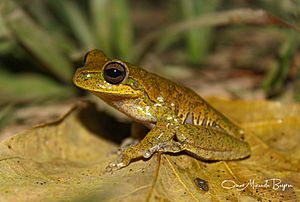Yungas tree frog facts for kids
Quick facts for kids Yungas tree frog |
|
|---|---|
 |
|
| Conservation status | |
| Scientific classification | |
| Synonyms | |
|
The Yungas tree frog (Boana balzani) is a type of frog that lives in trees. It belongs to the Hylidae family, which is a group of frogs often called "tree frogs." You can find this frog in two South American countries: Bolivia and Peru.
These frogs like to live in wet places. Their natural habitats include warm, moist forests that are not too high up (lowland forests). They also live in moist forests on mountains (montane forests). You might also spot them near rivers, canals, and even ditches.
Contents
What is the Yungas Tree Frog?
The Yungas tree frog is a small amphibian. Amphibians are animals that can live both on land and in water. Frogs are known for their strong jumping legs and their ability to climb. Tree frogs, like the Yungas tree frog, have special pads on their toes. These pads help them stick to leaves and branches, making them excellent climbers.
Where Does it Live?
The Yungas tree frog gets its name from the "Yungas" region. This area is a special kind of forest found on the eastern slopes of the Andes Mountains. It's a very wet and green place.
- Bolivia: You can find this frog in several parts of Bolivia.
- Peru: It also lives in certain areas of Peru.
These frogs prefer places with lots of moisture. They need water for their skin to stay wet and for their eggs to develop.
Forest Homes
The forests where the Yungas tree frog lives are often called "subtropical" or "tropical." This means they are warm all year round. They also get a lot of rain.
- Lowland forests: These are forests found at lower elevations. They are usually very warm and humid.
- Montane forests: These forests are higher up on mountains. They can be cooler but are still very moist, often covered in mist.
The frogs also use rivers and ditches. These water sources are important for drinking and for laying their eggs.
Life Cycle and Reproduction
Like most frogs, the Yungas tree frog starts its life in water. Frogs go through a process called metamorphosis. This means they change a lot as they grow up.
From Egg to Frog
- Eggs: Female frogs lay their eggs in water. These eggs are usually laid in groups, often called frogspawn.
- Tadpoles: After the eggs hatch, tiny creatures called tadpoles emerge. Tadpoles live in the water and breathe through gills, just like fish. They eat tiny plants and algae.
- Growing up: As tadpoles grow, they start to develop legs. First, their back legs appear, then their front legs. Their tails slowly get shorter.
- Young frog: Eventually, the tadpole's gills disappear, and it develops lungs to breathe air. Its tail completely disappears, and it becomes a small frog. This young frog then leaves the water and starts living on land and in trees.
What Do They Eat?
Adult Yungas tree frogs are carnivores. This means they eat other animals. They mostly eat small insects. Their long, sticky tongues help them catch their prey quickly.
Conservation Status
The Yungas tree frog is currently listed as "Least Concern" (LC) by the International Union for Conservation of Nature (IUCN). This means that, for now, there are enough of these frogs in the wild, and they are not considered to be in immediate danger of disappearing.
However, it's always important to protect their habitats. Forests are very important for many animals, including frogs. Keeping their homes healthy helps make sure these amazing creatures can continue to thrive.
See also
 In Spanish: Hypsiboas balzani para niños
In Spanish: Hypsiboas balzani para niños


